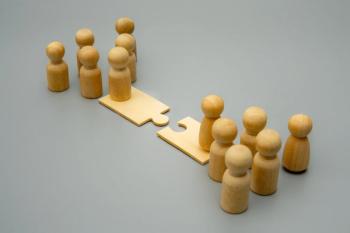
Eating Disorder Exploitation in Entertainment: Helping the Artists and Their Fans
Many artists who have struggled with an eating disorder are generating content that is promoted by the entertainment industry, and when these conditions go unaddressed, the content has the potential to influence consumers.
CLINICAL REFLECTIONS
In the biopsychosocial assessment model of
Many artists who have struggled with an ED are generating content that is promoted by the entertainment industry. When these conditions go unaddressed, the artists’ content has the potential to influence its consumers.
Entertainment Industry Exploitation
With mental health awareness on the rise, it is increasingly common to hear celebrities discuss their mental health and even express their challenges in their art. However, when the entertainment industry lacks standards for intervention when their talent’s suffering is evident in their lyrics, it sends a powerful message to society about which health issues are ignored and which are addressed. For example, the struggles with mental illness and
Warning signs of active ED symptoms are certainly present in the art of celebrities creating ED-related media. One such example is the Netflix film “To the Bone,” starring Lily Collins. Collins has publicly discussed her ED diagnosis, as well as her intentional 20-pound weight loss for the role. Project HEAL, whose mission is to “break down systemic, healthcare, and financial barriers to ED healing,”1 partnered with the film in 2017. In a statement, they noted their involvement began after filming had completed and asserted, “we in no way intend to endorse the idea that people with anorexia nervosa can lose weight safely… there is strong research showing that getting into a state of negative energy balance and/or losing weight can make people who have struggled with
Another example of this category of ED-related media is the music from Sara Kays. One cannot listen to her music without wondering what her management team is doing to help as she describes struggling with ED-related thoughts and behaviors. In a TikTok video, she shared the titles of her fans’ Spotify playlists that contain her music, which include, “im so ugly and i hate myself,” “Drowning in my depression,” “I f---ing hate myself,” “im so f---ing ugly and fat i just want to die,” “slowly giving up on everything..<3,” and “I Hate My Body and I Want To Be Skinny.”3 In a very painful-to-watch interview in front of a live audience,4 Kays is asked, “Are all these [mental health struggles] still very much a part of your soul and sort of your songwriting process?” to which Kays responds, “Do you mean have I gotten better, or…?” The interviewer appears to awkwardly change the subject to writing in the third person, avoiding a discussion about her current recovery. This interview could serve as a microcosm of public perception of how artists with mental illness are treated by the entertainment industry: exploitative with half-hearted and ill-timed attempts to address the condition. When media consumers witness their favorite artists continue to struggle with serious mental health conditions, they may lose hope for themselves or even begin to romanticize the illness.
Potential Benefits of ED-Related Media
Several studies have investigated hypotheses as to why individuals with depressive disorders tend to prefer listening to sad music. Yoon et al 2020 not only found that individuals with depression tended to prefer sad music compared to a healthy control group, but also that they felt happier after listening to said music.5 They hypothesized that the group with depression was attracted to the calm/low-energy nature of the sad music either because it is soothing or because of participants’ resistance to change in energy level.5 In Franz et al 2020, participants who read a first-person narrative about one’s struggles with
In the same way that individuals with depression may feel soothed by or connected through sad music, it is possible that consumers of this category of ED-related media may feel more understood or less alone in their experiences. For example, in one of Sara Kays’ TikTok videos, she sings about “things getting bad again.”7 Viewers’ comments range from support: “To anyone who relates to this, things will get better. Keep pushing through and soon enough you will feel better”; to identification: “I love this. it's beautiful and I relate to it”; to admiration, “we know [how] vulnerable you may feel putting these songs out there, but you know how much we relate to them. you’re not alone. none of us are alone.”7 It is possible that the reach of these songs extends beyond the simple listening process to social media spaces where individuals can comment and relay messages of support, hope, and connectedness.
Potential Risks of ED-Related Media
Although there may be some benefits to ED-related media created by artists with EDs, it is important to also understand the risks. A study of narrative data collected from a group of adolescents in rural Fiji 3 years after the introduction of television to the area suggested the onset of media-influenced weight/shape preoccupation and disordered eating behaviors.8 Themes from the interviews included a desire to lose weight to look like the individuals on TV, to buy exercise equipment that was advertised, and to look thin in order to improve chances for employment. Participants also discussed engaging in severe food restriction and using diet pills for
Barcaccia et al 2018 also found that female Italian adolescents’ disordered eating behaviors were correlated with their desire to be like TV characters, the amount of reality and entertainment TV they watched, and their perception of difference between their bodies and those of TV characters.9 Their friends’ desire to be like TV characters was also correlated with EDs. Although media may expose individuals to idealized looks and influence their own ED-related behaviors, the degree to which one’s peer group adopts those ideals appears to also have a significant impact on symptoms.
In addition to traditional entertainment media, social media has also been associated with body image and eating concerns via appearance-based social comparison.10 In one of the experimental studies reviewed, women who spent just 20 minutes on a social network site, compared to alternative websites, had greater concern about weight and shape.11 As a result of their review, the authors recommended limiting social media use when possible and advocated for media literacy programs with a focus on combatting negative body image.
Such media literacy programs could be conceivably delivered via short informal videos. In Meng et al 2015, 4 YouTube videos were created to increase awareness about disordered eating behaviors.12 The most effective video by participants’ self-report was one that explained the influence of mass media on
Furthermore, a review of the literature about celebrity influence on body image and EDs showed that celebrity self-disclosure about their past struggles with EDs was actually correlated with an increase in searches for pro-anorexia websites.13 Another study found that individuals are more likely to search for anorexia-related topics after searching for anorexia-linked celebrities, a phenomenon called “thinspiration” or inspiration to become thin. Several studies found that celebrity worship, as measured via the Celebrity Attitude Scale, was related to body concerns and ED attitudes. A few experimental studies found that exposure to magazine images of celebrities increased body dissatisfaction. There is also literature which suggests that the commentary included with celebrity images can increase body image concerns. Authors advocated for youth education about the impact of exposure to celebrity images.
Discussion
Empirically, it makes sense for the entertainment industry to be pressured to develop standards for helping their artists if their art contains evidence of mental health struggles. How might professionals in the mental health field advocate for this? We can start by addressing how ED-related content impacts those with EDs during patient visits. However, mental health professionals may also address problematic ED-related media with more large-scale efforts, including increasing public awareness of problematic ED-related content, establishing a line of communication with those in the entertainment industry, and developing recommendations for intervention when artists are struggling with mental health concerns, including EDs.
Just as we learned that commentary about celebrity images influences body dissatisfaction in its viewers, the types of discussions individuals have about ED-related media are very important in the impact they have on symptoms. For example, one conversation about “To the Bone” could be about the health concerns associated with restrictive eating patterns, while another conversation could be about body-comparison to the actors in the film. These very different discussion topics could bring about very different effects. Furthermore, different individuals may note an overall positive or negative impact from such media depending on their own personal traits and history. Additionally, the same person could note an overall positive or negative impact from ED-related media created by artists with EDs at different points in their life.
While some may feel more understood or connected after engaging with this content, others may feel an exacerbation of symptoms or even romanticize the illnesses of a celebrity they admire. Although there is literature to support the role of mass media in the development of EDs in general, this more nuanced category of media has, to our knowledge, not been well studied. However, we do know that celebrity self-disclosure of an ED is correlated with increased pro-ana searches.14
Next Steps
The future treatment of EDs could explore with the patient how to reduce problematic entertainment media influences or bolster positive ones if new research demonstrates its effectiveness. This category of ED related media has been a topic of concern for advocacy groups and social media companies as well. In a CNN interview, YouTube’s Global Head of Healthcare, Garth Graham was quoted: “allowing people to hear stories about recovery and allowing people to hear educational information but also realizing that the display of that information… can serve as a trigger as well.”15 Some ED related media created by artists with personal experiences of EDs may be incredibly nuanced and is not necessarily fully protective or harmful.
There are ethical limitations to studying this topic through an experimental design due to the empirical theory that individuals with EDs could be harmed by exposure to ED-related media created by artists with personal experiences of EDs. However, this could be explored in a study in which individuals with EDs are asked to describe entertainment media which may have influenced their symptoms or the onset of the disorder.
Furthermore, investigators could design a randomized control trial to determine whether an identification and intervention strategy would be helpful when entertainment media influences may be impacting recovery. In this type of a study, patients could be randomized to receive an active control versus a structured interview and counseling session(s) where motivational interviewing techniques are used regarding media identified as influencing ED symptoms. The hypothesis would be that those who received the identification and intervention strategy would have a shorter time to symptom remission. For the media influences which cannot be completely removed, perhaps the provider and patient could strategize how to manage the thoughts and behaviors that arise when exposed to problematic content. Alternatively, discussions may also include ways to bolster positive media influences identified in the counseling sessions.
Concluding Thoughts
Mass media is known to influence ED thoughts and behaviors. However, a new category of media regarding EDs created by individuals with personal experience of EDs has emerged. Further research should be conducted about the nuances of the effects of this media category so that providers can incorporate this information into treatment plans to promote recovery. The mental health field should pressure the entertainment industry to develop standards for helping their artists if there is evidence in their art that they are struggling with mental illness, and to limit the promotion of problematic ED-related media.
Dr Harness is an adjunct clinical assistant professor of Child and Adolescent Psychiatry, Psychiatry at University of Michigan. Dr Tocco is a clinical assistant professor of Child and Adolescent Psychiatry, Psychiatry at University of Michigan. Dr Prohaska is a clinical assistant professor of Child and Adolescent Psychiatry, Psychiatry at University of Michigan.
The doctors planto present a poster based on this paper on May 10, 2023 at University of Michigan.
References
1. ProjectHEAL. 2022. Accessed April 13, 2023.
2. Stromsodd J. How much weight Lily Collins lost for anorexia movie To the Bone. Your Next Shoes. November 10, 2021. Accessed April 13, 2023.
3. Kays S. are you guys ok. TikTok. September 11, 2022. Accessed April 13, 2023.
4. Sarah Kays - Interview 101.9 KINK, PNC Live Studio session. YouTube. June 27, 2022. Accessed April 13, 2023.
5. Yoon S, Verona E, Schlauch R, et al.
6. Franz PJ, Mou D, Kessler DT, et al.
7. Kays S. some quick thoughts from today. TikTok. August 12, 2022. Accessed April 13, 2023.
8. Becker AE.
9. Barcaccia B, Balestrini V, Saliani AM, et al. Dysfunctional eating behaviors, anxiety, and depression in Italian boys and girls: the role of mass media. Braz J Psychiatry. 2017;40(1):72-77.
10. Holland G, Tiggemann M.
11. Mabe AG, Forney KJ, Keel PK.
12. Meng J, Bissell KL, Pan PL.
13. Brown Z, Tiggemann M.
14. Lewis SP, Klauninger L, Marcincinova I.
15. Duffy C. YouTube rolls out new policies for eating disorder content. CNN. April 18, 2023. Accessed April 18, 2023.
Newsletter
Receive trusted psychiatric news, expert analysis, and clinical insights — subscribe today to support your practice and your patients.

















